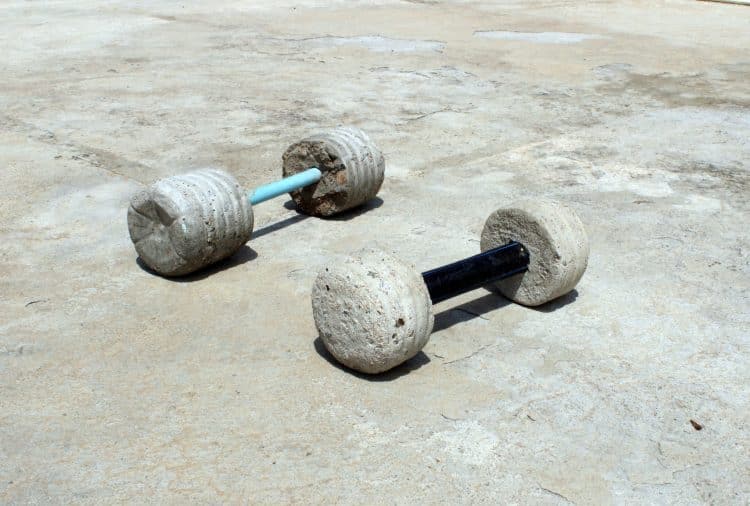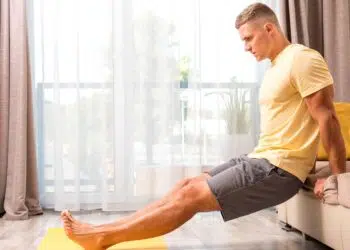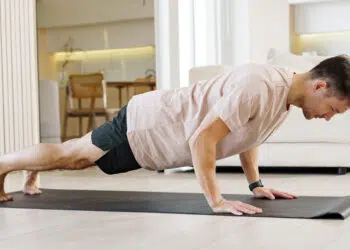What more? You don’t even need dumbbells for dumbbell exercises. Confused? Remember when we were trapped inside our own homes during the pandemic in 2020? We used all sorts of things instead of the dumbbells to get in a good workout. That said, many of the tools used as dumbbell replacements weren’t as effective.
Many people recommend lifting canned food instead of dumbbells at home. It is an excellent idea if you’re three years old or hate the idea of building muscle mass or strength. Most canned foods weigh less than a pound, which limits their muscle-building potential.
But Why DIY Dumbbells?
If you’ve ever shopped for gym equipment, you would know that dumbbells are surprisingly expensive. A rack full of dumbbells can cost more than an entire home gym setup, including a weight bench, barbell, 200-pound weight plates, and a squat rack.
Although adjustable dumbbells are gaining popularity in the home gym community, most adjustable dumbbells have an awkward shape and don’t come cheap. Bowflex SelectTech 552 Adjustable Dumbbells are arguably the best adjustable dumbbells on the market, and a pair costs $550. Plus, since there are several moving parts in an adjustable dumbbell, they usually aren’t as sturdy as fixed dumbbells.
So, I thought, why not put together a list of budget-friendly DIY dumbbell ideas for the average consumer so they can get a commercial gym-quality workout in the comfort of their homes? You could use these dumbbells in your garage gym on days when you don’t have the time to hit the gym, or if, god forbid, we are locked indoors due to a pandemic again.
Level Up Your Fitness: Join our 💪 strong community in Fitness Volt Newsletter. Get daily inspiration, expert-backed workouts, nutrition tips, the latest in strength sports, and the support you need to reach your goals. Subscribe for free!
DIY Dumbbell Ideas
Without further ado, here are the six best DIY dumbbell ideas:
Backpack
Backpacks are the most versatile type of weights for training at home. In contrast to the fixed-weight dumbbells, you can easily add or remove weight from a backpack to suit different exercises. Plus, backpacks allow you to go heavy in your workouts. These things can hold a lot of weight.
Backpacks are also the most accessible; most of us have a few bags from our school or college days lying around. That said, I recommend using a backpack with a grab handle on the top, as it mimics a dumbbell’s handle. Backpacks with shoulder straps are great for exercises like weighted push-ups, pull-ups, or running, but you’ll need a grab handle for lifts like the biceps curl or bench press.
How To Use Backpacks as DIY Dumbbells
Let’s say you want to perform biceps curls. Here’s how to do it using a backpack:
- Fill the backpack with the appropriate weight. You could use books, magazines, supplement containers, or other heavy things for this.
- I recommend using two backpacks and filling them with the same things.
- Hold the grab handles with a supinated (underhand) grip.
- Stand upright with a hip-width stance.
- Keeping your upper arms tight to your torso, curl the bag until your hands are at shoulder level.
- Pause and contract your biceps at the top of the range of motion.
- Slowly return to the starting position.
- Repeat for the recommended reps.
Ensure that your bag is in good condition. A backpack with weak grab handles or a worn-off bottom can rip during your set, putting you at risk of injury. You could also use duffle bags, gym bags, or hardcase suitcases for most exercises.
Water Bottle Dumbbells
This is probably the most common DIY dumbbell idea. Many people use water bottles as dumbbells while waiting at the bus stop, in line at the grocery store, traveling, or working out in their living room.
Most people use one-liter bottles as dumbbells, which is usually not enough weight. I want to take things one step further. But you cannot grab more than one water bottle in each hand.
How To Use Water Bottles as DIY Dumbbells
So, here is a quick and easy way of lifting more weights using this convenient tool:
Things You Need:
- 16 1-liter water bottle
- Duct tape
- PVC pipe
- Water
- Blade
Steps:
- Take a PVC pipe and saw it using a blade so you have two 12-inch pieces.
- Take four filled water bottles and tape them around one end of a PVC pipe. Make sure the bottoms of the bottles are facing each other.
- Besides taping the bottles together, wrap the tape around the handle to ensure the bottles won’t move around during your set.
- Repeat on the other end.
- With this, you have a 4-pound dumbbell.
- Use the same steps to make your second water bottle dumbbell.
I recommend using 1-liter water bottles. Additionally, you should use bottles that are shorter and wider. Using tall bottles can interfere with your movement mechanics in exercises like the dumbbell curl.
Also, you could use an iron pipe instead of a PVC pipe. Iron pipes are heavier and can add to the overall weight of your DIY dumbbell. However, you might need power tools to saw the iron pipe.
Milk Jug Dumbbells
Milk jugs or gallon bottles are the obvious next step to the water bottle dumbbells. They are bigger in size and hold more weight. Furthermore, milk jugs have a built-in handle, making them better suited for your workouts.
Using milk jugs as DIY dumbbells is pretty straightforward. You fill them with water, secure the lid, and use them as dumbbells. Notably, since the handles are near the jug’s neck, it might slightly change your movement mechanics.
For example, although you could use milk jugs for a supinated-grip biceps curl, the neutral (palms facing your body) would be a more natural hand position. Expect to make minor grip tweaks in every exercise while using milk jugs.
Experienced exercisers should get bigger water jugs to ensure optimal stimulus for strength and muscle gains.
You could also use the same PVC pipe technique from the previous step on milk jugs. However, I recommend limiting yourself to four jugs per dumbbell; otherwise, it can hinder your range of motion.
Pro Tip: Instead of using water to fill the bucket, you could use pebbles or sand, as they have greater density than water, meaning the same amount of pebbles or sand will weigh more than water.
Alternatively, you can use paint or water buckets. The weight of a paint or water bucket is usually mentioned on the label. Remember, one liter equals one kilogram. A five-liter paint bucket weighs five pounds.
Kettlebells
I know what you’re thinking. “But we came here to learn about making DIY dumbbells.” Well, guess what? Milk jugs aren’t dumbbells, either. When we say DIY dumbbells, we’re mostly referring to weights that can be lifted with one hand and used for exercises like biceps curls and bench presses. The kettlebell dumbbells tick all the right boxes.
There are several ways of doing this, but I will take you through the one that gives you the best-finished product and will last you a lifetime. That said, it might require a little more time and supplies.
This DIY dumbbell involves making a Russian kettlebell with a soft rubber ball and a PVC pipe. But the best part is, it will cost you less than $10; you’re welcome.
How To Make DIY Kettlebells
Here is a step-by-step guide to make your own kettlebells using a soft rubber ball, cement, and a PVC pipe:
Step 1: Materials & Tools Required
You’ll need the following materials and tools for the DIY kettlebell:
Materials:
Level Up Your Fitness: Join our 💪 strong community in Fitness Volt Newsletter. Get daily inspiration, expert-backed workouts, nutrition tips, the latest in strength sports, and the support you need to reach your goals. Subscribe for free!
- 1 bag quikrete pre-mixed concrete mix
- 1 soft rubber ball (under $5)
- 26″ of 3/4″ or 1″ PVC
- Sand
- Duct tape
- Water
Tools:
- 1 Hacksaw or jigsaw
- 1 Heat gun
- One Bucket (for mixing)
- 1 small garden spade or similar tool (for mixing and transferring concrete to the ball)
- 1 pair of scissors
Step 2: Get the Handle Ready
The PVC pipe handle is the DIY kettlebell’s one of the most important components. You must pay close attention to the entire process, as a single misstep could lead to an uncomfortable training experience.
You could use a PVC conduit pipe instead of a potable pipe, as it costs less and works the same. Cut the PVC to a 26-inch length using a hacksaw. Cover one end of the PVC pipe with duct tape. Fill the PVC pipe with sand through the other end before sealing it. The sand will help maintain the PVC pipe’s roundness while it’s being heated and shaped.
Step 3: Shape the Handle
Use a heat gun until the PVC pipe is pliable enough to bend. Turn the pipe into a kettlebell handle shape while it is hot. Wear mittens or wrap your hands with a thick layer of cloth to avoid burning.
Ensure that the PVC remains in the shape until it cools down. You might have to place it between heavy objects to prevent it from returning to its original form. Remember, you can always reheat and reshape the handle if you’re unhappy with the outcome.
Step 4: Get the Ball Ready
The rubber ball will provide the cannonball shape for our DIY kettlebell. It also acts as a layer of protection between the concrete and the floor. Place the handle on top of the rubber ball and mark the areas where the two edges of the handle touch the ball. Cut out the areas. Then, slit the ball open between the two marks and empty the ball.
The size of the rubber ball will determine how much cement you can add to it and its subsequent total weight.
Step 5: Finish the Kettlebell
Add an appropriate amount of Quikrete into a bucket to fill the rubber ball and add water until the concrete mixture is a thick paste.
Use a garden spade to transfer the concrete mixture into the ball. Use the spade to press down on the cement to create a round base at the bottom. It will prevent the kettlebell from rolling around when not in use.
When the kettlebell is almost filled with cement, insert the PVC handle to a comfortable depth. The top of the handle shouldn’t be too close to the cannonball, making holding the ball and performing cleans impossible. Conversely, setting the grip too far away from the cannonball will throw off its balance.
With the handle settled, add more concrete and fill the rubber ball to the brim. Tap the kettlebell on the floor a few times to ensure the cement is settled. Let the cement set for 24 hours.
Return after 24 hours. Give the cement some more time to dry if it is moist. Conversely, you can do your first set of kettlebell dumbbell curls if the cement is dry and set.
Credits: Instructables.com
Sand Dumbbells
Since sand is more dense than water, you can make heavier DIY dumbbells using it. You could sand in the water jug and water bottle dumbbells mentioned above, but this is a more sophisticated solution. Here is what you need and how to do it:
Things You Need:
- Two 20oz (600 ml) plastic bottles
- 10 pounds of sand
- Wooden dowel (two 4-inch pieces)
- Four screws
- Paper
- Saw
- Screwdriver
- Measuring tape
- Utility Knife
- Marker or pen
Steps:
Before beginning, you must ensure the wooden dowel fits inside the bottleneck. Remember, the tighter the fit, the better. If the wooden dowel is too loose inside the bottleneck, it adds a few more steps to the process. We must then insert a cloth between the bottleneck and the dowel and wrap it with duct tape to ensure the pipe doesn’t move during the exercise. With that out of the way, here is how to make a DIY dumbbell with sand:
- Cut out the bottles’ top and bottom half right above and below the labels using a utility knife.
- Insert the top half into the bottom half and secure them using duct tape.
- Repeat for the second bottle.
- Take two wooden dowel pieces that are 12 inches (30 cm) long. These will be the dumbbell handles.
- Roll a piece of paper into a funnel shape and secure it using duct tape so it doesn’t lose its shape.
- Fit the cone into the bottleneck and fill it to the brim with sand. Ensure there is no empty space in the bottles, as it can lead to instability during an exercise. Pat the sand down using a wooden stick if necessary.
- Repeat this on the second bottle.
- Press the dowel pipe into the bottle, approximately 4 inches (10 cm) deep.
- Using a screwdriver, screw the dowel into the bottle through the bottleneck.
- Repeat it on the other end.
It might be easier to screw the dowel to the bottleneck using an electric screwdriver. I recommend screwing through the dowel before you insert it in the bottleneck. The same applies for the bottle. Screw threw it before inserting the dowel.
Concrete Dumbbells
Concrete dumbbells are as close as you can get to commercial gym-quality dumbbells at home. However, they also require the most amount of work, investment, and time.
We’ll use the same video from the ‘sand dumbbells’ section to demonstrate the concrete dumbbells. Concrete dumbbells can take up to a week to complete, depending on when the concrete dries.
Things You Need:
- 1 small bucket with 2 parts sand
- 1 small bucket with 1 part cement
- 2 empty small buckets
- Wooden dowel (two 4-inch pieces)
- 20 screws
- White glue
- Sandpaper
- Medium-sized paint brush
- Bucket of water
- Duct tape
- Screwdriver
- Measuring tape
- Utility knife
- Marker or pen
Steps:
- Screw 10 screws into each side of the dowel. The screws don’t need to be in any pattern but must be spread out as they will help the cement stick onto the dowel. The screws should stick out about 1-1.5 inches (2.5-4 cm) from the dowel.
- Pour two parts sand and one part cement into a small bucket and stir it.
- Add one tablespoon of white glue to a container with about two cups of water.
- Add the water and glue mixture to the sand and cement bucket. Mix well until the combination has a thick, cream-like consistency.
- Place one end of the dowel into the mixture. Ensure the dowel is straight, as it will be your DIY dumbbell’s handle. A tilted dowel will throw off its center of gravity and make using it inconvenient.
- Allow the cement to dry for two to three days. The time can vary depending on the amount of mixture you’re using and the room temperature.
- Repeat steps two to six to prepare the second end of the dumbbell. However, in the last step, you must place the dried cement bucket over the newly created one.
- Allow the cement to set for two to three days.
- Use a utility knife to cut off the plastic buckets. Employ a hot gun on the plastic buckets and heat the knife to make the process easier.
- Use sandpaper to smoothen the dumbbell’s edges.
- Mix two parts of glue with one part of water in a container.
- Apply the mixture on both ends of the dumbbell using a paintbrush. It will help improve the dumbbell’s longevity.
Benefits of DIY Dumbbells
Using DIY dumbbells has the following advantages:
Build Muscle and Strength
DIY dumbbells can help build strength and muscle mass. Perform three to five sets of eight to 12 reps using an appropriate weight to bias hypertrophy. You must establish a mind-muscle connection and contract your target muscles with each rep for optimal results. (1)
Progressive Overload
Most people who train at home are limited to bodyweight exercises. These budget-friendly and convenient DIY dumbbells can help provide the necessary stimulus to ignite new growth and rip through strength and muscle plateaus.
Versatility
Dumbbells are incredibly versatile. You can use them to train virtually every muscle group, from your forearms to your calves. Making your own DIY dumbbells will ensure you don’t have any weak muscle groups. Plus, they can be programmed into any training regimen.
Budget-Friendly
All the DIY dumbbell ideas listed in this article can be done below $20. On the contrary, commercial dumbbells can cost you at least five times this amount. Dumbbells can break down on rough usage, and if you use commercial dumbbells, it can add up to a lot.
Sample DIY Dumbbells Full-Body Workout
Here is a DIY dumbbell workout to train your complete body:
| Exercises | Sets | Reps |
| Dumbbell Bench Press | 3 | 8-12 |
| Dumbbell Shoulder Press | 3 | 8-12 |
| Bent-Over Dumbbell Row | 3 | 8-12 |
| Dumbbell Biceps Curl | 3 | 8-12 |
| Dumbbell Overhead Triceps Extension | 3 | 8-12 |
| Goblet Squat | 3 | 8-12 |
FAQs
How much would a pair of DIY dumbbells cost?
The cost of a DIY dumbbell set depends on your preferences. You probably already have a few water bottles or a backpack in your house. In this case, your DIY dumbbell set costs you nothing. However, if you want to build the cement DIY dumbbell set, it can cost you up to $20.
Are DIY dumbbells as effective as commercial gym dumbbells?
Yes. DIY dumbbells are as effective as commercial ones. However, you must progressively overload your muscles with additional volume, intensity, training, frequency, and weight to ensure consistent progress.
How long do the DIY dumbbells usually last?
It will depend on your usage and your pick of DIY dumbbells. Water bottles might last a few months, whereas cement dumbbells will last several years. Be prepared to make new dumbbells soon if you are in the habit of throwing your dumbbells to the floor after each bench press set.
More DIY:
- DIY Kettlebells 2025: Build Your Own for a Fraction of the Price
- Forget Commercial Protein Bars — 6 Homemade Protein Snacks for Cleaner Eating and Better Nutrition
- Fitness on a Budget: Affordable Ways to Stay Fit in the New Year
- How To Clean Horse Stall Mats in Home Gyms
- 6 DIY Homemade Weight Bench Ideas – The Ultimate Guide
- 6 DIY Weight Plate Storage Ideas For Your Home Gym
- 7 Easy DIY Barbell Holder Ideas For Your Home Gym
- 15 Best Homemade Gym Equipment For Your New Garage Gym
Wrapping Up
Adding dumbbells to your at-home training routine can take your gains to the next level. As you know by now, making DIY dumbbells isn’t that complex and can be done without breaking the bank.
This DIY dumbbell list includes six ideas you can use depending on how much time and effort you’re willing to put into the project. I recommend the milk jug dumbbells if you’re looking for something easy. However, if you want to go for the commercial gym feels and have some time to spare, you should give the concrete dumbbells a shot. Best of luck!
References
- Schoenfeld BJ, Grgic J, Van Every DW, Plotkin DL. Loading Recommendations for Muscle Strength, Hypertrophy, and Local Endurance: A Re-Examination of the Repetition Continuum. Sports (Basel). 2021 Feb 22;9(2):32. doi: 10.3390/sports9020032. PMID: 33671664; PMCID: PMC7927075.
Article Updates Timeline:
Our editorial team experts constantly update the articles with new information & research, ensuring you always have access to the latest and most reliable information.
January 10, 2024
Updated By
Vidur Saini
September 4, 2023
Updated By
Vidur Saini
August 29, 2023
Written By
Vidur Saini
Updated By
Editorial Team










